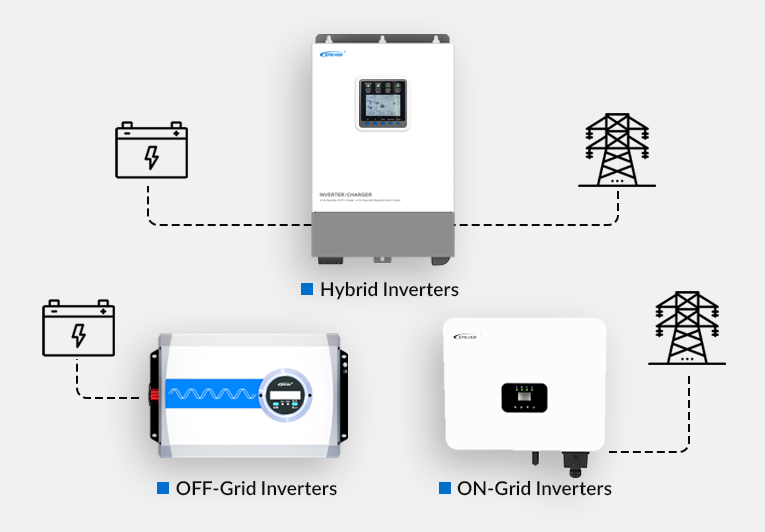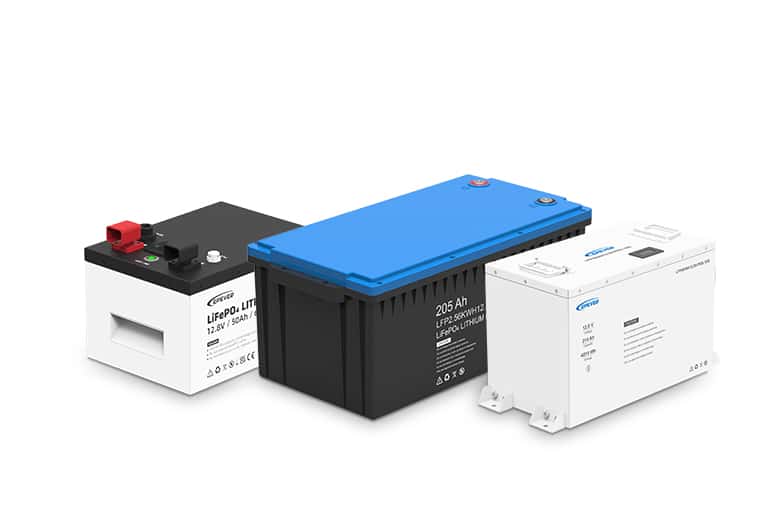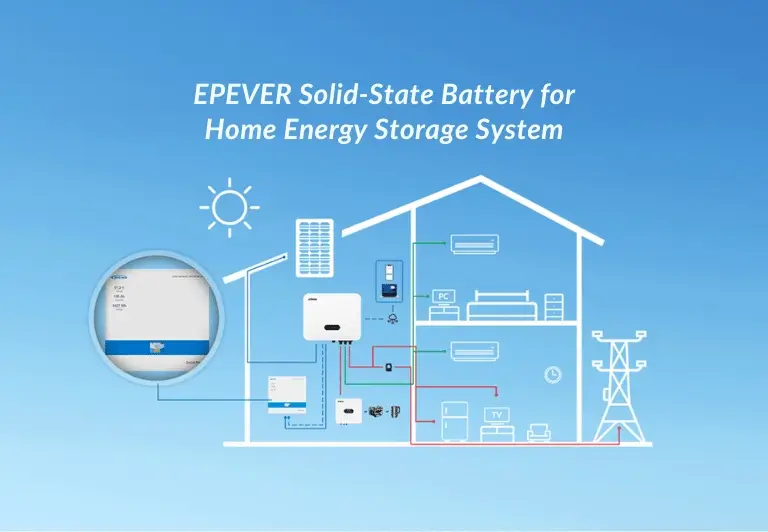ATZ Series portable power station: Inspire you to relish your lifestyle
- 7 June 2024
- 1704 views
- No Comments
ATZ Series portable power station: Inspire you to relish your lifestyle
What is ATZ series portable power station?

What are the features of ATZ series?
Key features:
· High Capacity: The built-in lithium battery starts at 2048Wh and can be expanded to 4096Wh with additional battery packs, providing ample power for a range of needs.
· Power Output: It delivers up to 3600W of continuous power and can reach a peak output of 5400W.
· Connectivity for Control and Monitoring: Includes Wi-Fi, Bluetooth, and a wireless remote controller. The EPEVER app allows for straightforward monitoring and adjustment of settings.
· Enhanced Visibility: An ambient light feature offers gentle illumination in low-light conditions, aiding in the location and operation of the device.
Distinctive Features:
· Versatile Applications: Ideal for RV camping, aerial photography, outdoor operations, and home backup.
· Multiple Charging Options: Can be charged via solar power, car charger, or diesel generator.
· Rapid Charging Capability: The main battery pack can be fully charged in just 1.2 hours with AC power and optimal PV (photovoltaic) input.
· Durability and Cycle Life: Features a battery management system (BMS) that ensures over 3000 charge cycles at a depth of discharge (DOD) of 70%.
· Portable Design: The power station is compact and includes dual-wheel handles and LED ambient lighting for easy transport and setup.
· Built with Safety in Mind: Encased in a 5VA flame-retardant shell to ensure both safety and durability.
· Intelligent Energy Management: Offers an energy-saving mode and a silent charging operation, minimizing noise to just 30dB.
· Comprehensive Output Options:
· AC Output: Four 230V EU Schuko sockets.
· DC Output: Two 12VDC/10A car charging ports.
· USB Ports: Four USB-A and four USB-C ports, including two 100W PD (Power Delivery) ports for rapid charging of compatible devices.
With these features, the ATZ Series Portable Power Station not only meets but anticipates the needs of modern adventurers and homeowners looking for reliable, portable power solutions.
ATZ Portable Power Station's Appearance?
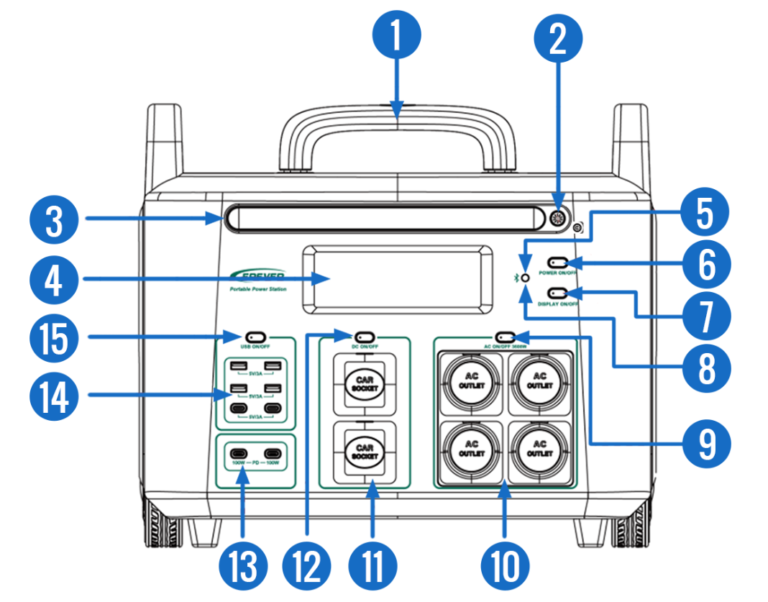
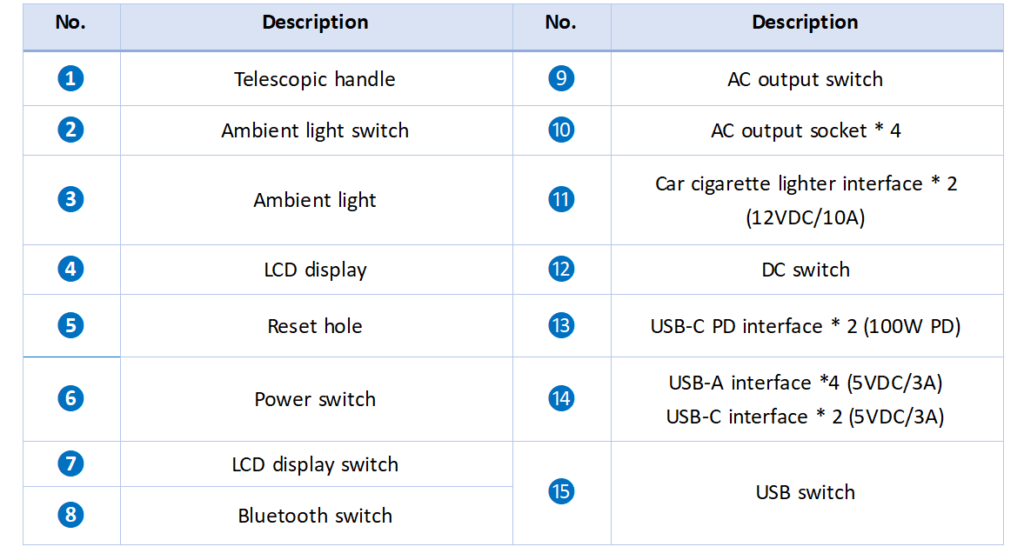
Front Panel Configuration:
1. Telescopic Handle: The device features a handle with a dual-wheel system, enhancing portability and ease of movement across different terrains.
2. Ambient Light Switch: Activates the ambient light.
3. Ambient Light: Provides a built-in light that provides illumination in low-light conditions, aiding in device operation.
4. LCD Display: Displays real-time information regarding power usage, battery status, and system alerts, facilitating easy monitoring and adjustments.
5. Reset button: A small, recessed button used to reset the device’s software in case of errors or malfunctions.
6. Power Switch: This main switch controls the power to the entire unit, allowing for a quick power on/off operation.
7. LCD Display Switch: Allows users to turn the display on or off to conserve.
8. Bluetooth Switch: Enables wireless connectivity, allowing the device to interface with other Bluetooth-capable devices for enhanced control and monitoring.
Output Interfaces:
1. AC Output Switch: Controls the AC power output, enabling or disabling the flow of AC electricity from the device.
2. AC Output Sockets (x4): These four sockets provide AC power to connected devices such as kitchen appliances, tools, and other equipment requiring alternating current.
3. Car Cigarette Lighter Interface (x2, 12VDC/10A): These ports are designed for charging or powering devices that are compatible with a standard 12V car charger.
4. DC Switch: Manages the DC output from the device, allowing for control over devices connected via DC power.
5. USB-C PD Interface (x2, 100W PD): High-power USB-C ports that support Power Delivery up to 100 watts, suitable for fast charging laptops, tablets, and other compatible devices.
6. USB-A Interface (x4, 5VDC/3A) and USB-C Interface (x2, 5VDC/3A): Standard USB-A and USB-C ports for charging mobile phones, cameras, and other small electronics.
7. USB Switch: It controls outputs of USB-A and USB-C.
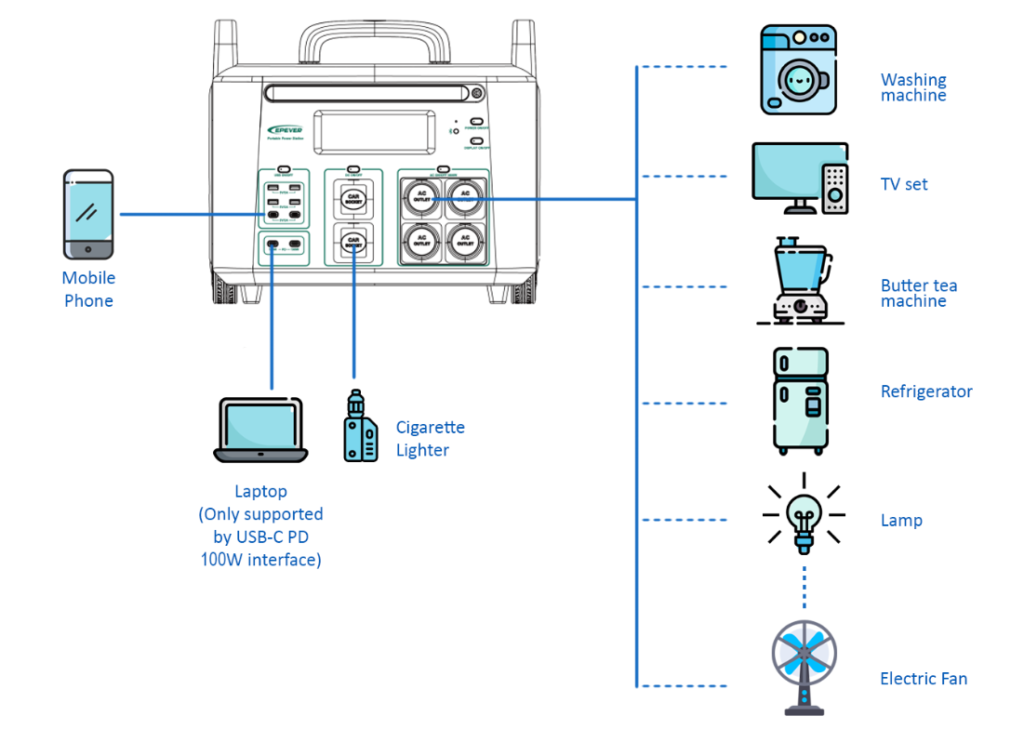
ATZ LCD display
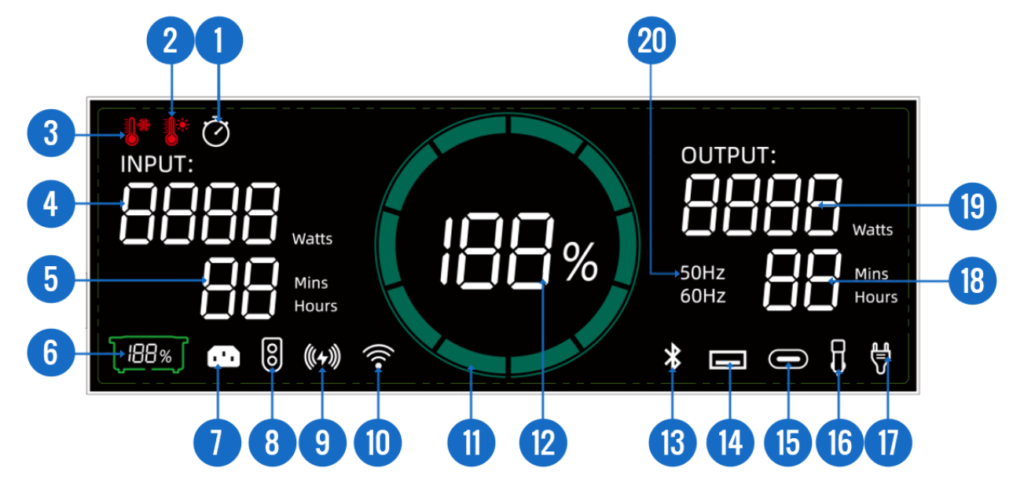
LCD Display Features and Functionality of the ATZ Portable Power Station:
The LCD display on the ATZ Portable Power Station is designed to provide comprehensive real-time data that enhances user interaction and ensures efficient monitoring. Below are the key icons and their functions:
1. Timing Icon: Indicates active timers set through the mobile app. It stays illuminated while the timer is active and turns off when deactivated.
2. High Temperature Warning Icon: Alerts users when either the main or secondary battery pack exceeds predefined high temperature thresholds, signaling potential overheating.
3. Low Temperature Warning Icon: Notifies users when the temperature drops below the safe operational threshold, important for maintaining battery health.
4. Input Power Icon: Shows the status of combined DC charging and AC input power. It remains lit when power is flowing into the device and turns off in the absence of input power.
5. Remaining Charging Time Icon: Provides an estimate of the time left until the battery is fully charged, displaying various time intervals for better planning.
6. Secondary Battery Pack Icon: Displays the connection status and remaining power of any connected secondary battery packs, along with related input statuses through AC Input and DC Input icons.
7. AC Input Icon: Monitors the status of the AC relay within the device, ensuring that the AC power is properly relayed from source to outputs.
8. DC Input Icon: Indicates whether DC voltage is being supplied to the device, essential for understanding power sourcing status.
9. Wireless Charging
10. Wifi Icon
11. Battery Level Bar: Represents the state of charge (SOC) of the battery in ten segments (R1 to R10), with each segment denoting a 10% increment in battery level.
12. Remaining Battery Level Icon: Provides a precise digital readout of the battery’s SOC as a percentage, allowing for accurate monitoring of battery status.
13. Bluetooth Icon: Checks the output status of the Bluetooth button.
14. USB-A, USB-C Icon: Checks the Bluetooth status of the USB switch.
15. USB-C PD Icon: Indicates if a device is connected to the USB-C PD interface or not.
16. Cigarette Lighter Icon: Checks the output status of the DC switch.
17. AC Output: Checks the status of the load output relay.
18. Remaining Battery Runtime: Informs about the estimated runtime left on the battery under current load conditions, illuminating during discharge and turning off when inactive.
19. Output Power Icon: Indicates the total power output being utilized from both AC and DC sources, useful for energy management and device operation.
20. Frequency Feature: Monitors and displays the frequency of AC output. It shows a standard 50 Hz for frequencies between 40-55 Hz and 60 Hz for frequencies between 56-70 Hz, ensuring compatibility with various regional power standards.
These features collectively provide a detailed overview of the power station’s operational status, contributing to a user-friendly experience by facilitating easy checks and adjustments directly from the front panel of the device.
ATZ back view
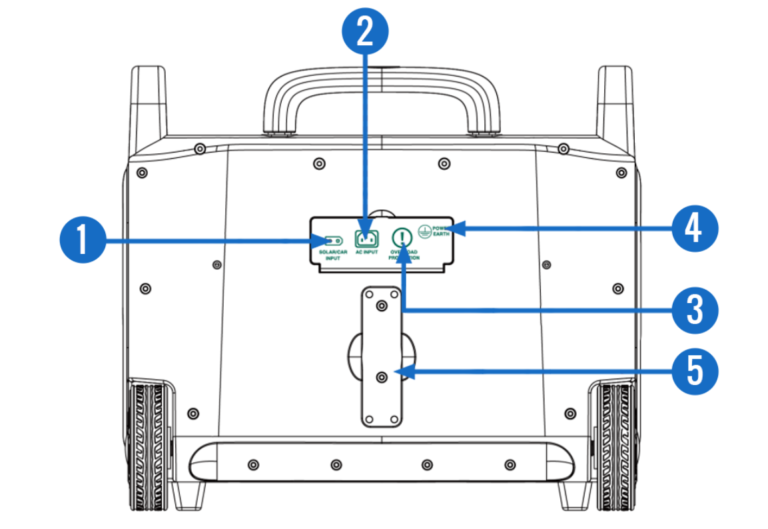
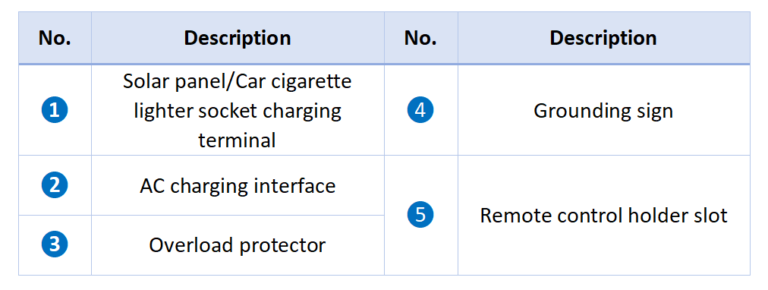
Solar Panel/Car Cigarette Lighter Socket Charging Terminal:
· Solar Panel Input: This input allows the power station to be charged using solar energy. It is particularly beneficial for outdoor enthusiasts engaging in activities such as camping, hiking, or during emergency situations where traditional power sources are unavailable.
· Car Cigarette Lighter Socket: Enables charging of the power station using the electrical system of a vehicle. This feature is essential for maintaining device charge while traveling, ensuring that power is available on-the-go.
Remote Control Holder Slot:
· Located on the back of the device, this slot holds a remote control that facilitates the wireless operation of the power station. The remote includes buttons for:
· Turning the device on and off.
· Controlling both DC and AC outputs.
· Managing Bluetooth connectivity for enhanced device communication.
· Activating the ambient light switch.
· Managing USB outputs for connected devices. This integration enhances convenience by allowing users to control the power station’s functions remotely, making it more accessible in varied usage scenarios.

ATZ top view
Secondary Battery Pack Terminal:
· Positioned on the top of the device, this terminal serves as the connection point for an additional secondary battery pack. The power station is initially equipped with a 2048Wh lithium iron phosphate battery, which can be expanded to 4096Wh by adding another battery pack.
· The design facilitates easy expansion as no external connection lines are required; the additional battery simply integrates into the existing system through this dedicated terminal.
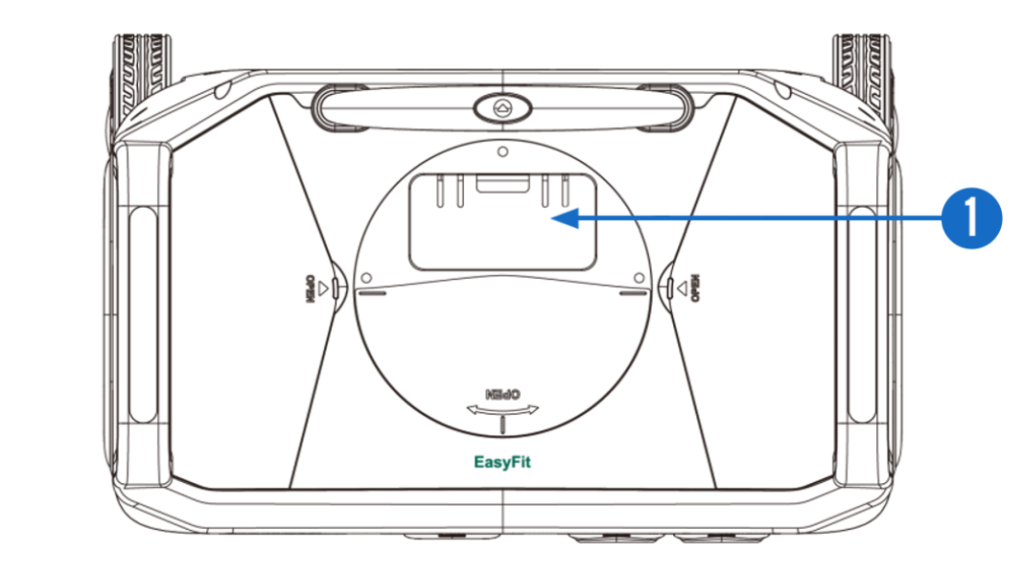

Utility and Ergonomics:
The design of the ATZ portable power station emphasizes functional simplicity and user-friendly interaction. The layout of switches and interfaces ensures that all controls are easily accessible and marked, supporting efficient operation and maintenance. This arrangement not only meets technical requirements but also enhances user experience by making power management straightforward and intuitive.
Is it worth getting a portable power station?

Imagine you’re heading out camping with your family. You plan to stay at a site without access to electricity, so you bring along the ATZ Portable Power Station. With a 2048Wh capacity, here’s how it could power a typical setup:
Daily Device Usage Overview
As your family sets up camp, the ATZ Portable Power Station begins powering several key devices:
· Small Refrigerator: Keeps your food and drinks cold throughout the day and night.
· Laptop: Used by the kids for watching movies in the evening.
· Smartphones: Everyone’s phones need recharging after using them for photos and GPS.
· LED Light Bulb: Lights up your campsite for safety and convenience after sunset.
· Coffee Maker: Essential for starting your morning right with a couple of cups of coffee.
Calculating Total Daily Consumption:
· Small Refrigerator (50W): Runs 24 hours = 1200Wh
· Laptop (30W): Used for 2 hours in the evening = 60Wh
· Smartphones (5W each): 4 smartphones charged for 2 hours each = 40Wh
· LED Light Bulb (10W): Used for 5 hours in the evening = 50Wh
· Coffee Maker (1000W): Used for 15 minutes per cup, 2 cups = 250Wh
Total Consumption:
1200Wh + 60Wh + 40Wh + 50Wh + 250Wh = 1600Wh
What else could be added with the remaining capacity?
With about 448Wh left, you could consider additional or longer usage of high-consumption devices:
· Portable Electric Grill: Have a barbecue dinner, using a 1500W grill for about 20 minutes would consume an additional 500Wh, which slightly exceeds your remaining capacity, so you might choose to use it more sparingly or opt for another day when less power has been consumed.
· Portable Fan: If it’s a hot night, running a 40W fan for the entire night (10 hours) would use up 400Wh, fitting comfortably within your available power.
Extended Capabilities with Additional Power:
Doubling the capacity to 4096Wh would mean not having to ration power as strictly. You could easily accommodate the electric grill for a longer barbecue, add a second or third fridge for beverages, or even run higher-powered appliances like a small air conditioner or heating units if the weather calls for it.
This example shows how the ATZ Portable Power Station can meet the varied needs of a family camping trip, providing flexibility and convenience even off the grid. With its substantial capacity and the option to expand, it ensures you can bring the comforts of home into the wilderness.


